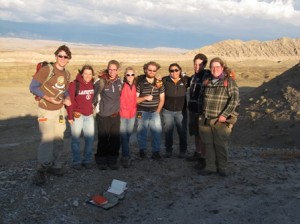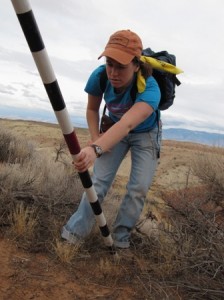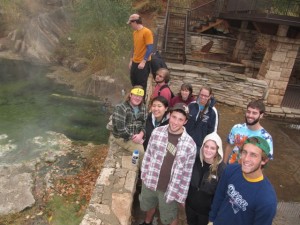 When colleagues Larry Malinconico and David Sunderlin of the department of geology and environmental geosciences would get together and discuss their field work with students, they noticed a lot of parallels.
When colleagues Larry Malinconico and David Sunderlin of the department of geology and environmental geosciences would get together and discuss their field work with students, they noticed a lot of parallels.
“We always ended up going to the same locations, but talking about them from our different disciplines,” Sunderlin says.
They realized that geology majors would be better served if the material from their upper-level classes was integrated into a two-semester sequence in which sedimentology and structure were covered in tandem. The result is a new team-taught course, Basin and Structural Analysis: Integrated Teaching in a Tectonic Framework. The first section of the course was taught during the spring semester, and students are continuing the sequence this fall.
In talking to geology faculty at other colleges and universities, Malinconico and Sunderlin have learned that there is lot of interest in this uncommon concept, suggesting that their new Geology 317 course could be a model for other geology departments around the country.
The class places an emphasis on field work, with the highlight being a four-day mapping project around the northern portion of the Sheep Mountains near Greybull, Wyo., over fall break. The trip provides students with the opportunity to synthesize a complete geologic story for the mapping area and place it into a regional tectonic framework using the tools they have acquired over the year, Malinconico says. The trip is funded by Lafayette, so expenses for the students are minimal.
“The area presents an interesting and challenging puzzle for students at this level,” Malinconico says.
Sunderlin and Malinconico conducted a trial run of the field project last fall. They believe that the Wyoming field work helps students understand how the concepts they study in class translate to real-world research.
“I think one thing students start to appreciate after being in the field in Wyoming is the nuances of the data,” Sunderlin says.
For example, students begin to realize that real field data has missing pieces, unlike in textbooks where all the data is neatly laid out. That realization forces them to develop and test their own hypotheses.
Another benefit of the Greybull trip is the ability to study rock formations that aren’t obstructed by vegetation, as they often are in Pennsylvania. Once students have seen the bare rock in Wyoming, they are better equipped to visualize similar structures closer to home, even when greenery gets in the way.
Upon returning from the Greybull trip, Jennifer Bell ’11 (Purcellville, Va.) remarked to Malinconico, “Now I feel like a geologist.”
Sean Murphy ’11 (Stoughton, Mass.) another geology major, went on both trips, the second time as a teachers’ assistant.
“There’s something about hiking several miles and studying geology in 20 degree weather in the middle of nowhere that really turns a group of students and professors into a group of friends,” he says.
Murphy appreciates the perspective that the instructors have brought to the class and the field work.
 “Dr. Malinconico has taught me how to think of geology in four dimensions,” he explains. “Understanding structural geology involves thinking about how rocks and sediments change physically (in three dimensions) over the course of millions of years (time),” Murphy says.
“Dr. Malinconico has taught me how to think of geology in four dimensions,” he explains. “Understanding structural geology involves thinking about how rocks and sediments change physically (in three dimensions) over the course of millions of years (time),” Murphy says.
Geology major Bryan McAtee ’11 (Round Hill, Va.) was part of the group that traveled to Greybull last fall. He later returned to do research for his senior thesis.
“This class is the epitome of experiential learning,” he says. “It is hard to imagine how any other class could help me learn more about what it means to be a geologist.
“The two-semester format makes perfect sense because the processes covered in sedimentology/stratigraphy and tectonics are together responsible for a large portion of the geology we see today. Also, while the subject material for both classes is interesting and engaging, the collaboration between the professors makes it easier to see the bigger picture.”


